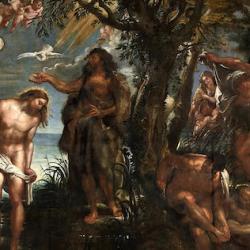In his study of Justification in Earlier Medieval Theology, Charles Carlson concludes that early medieval commentators on Paul did not give any special attention to justification. For most of the early scholastics, “justification” was a synonym for the remission of sins, and prior to the thirteenth century it was not developed into a precise doctrinal formula. They agreed that “faith alone pertains to justification and that it is bestowed by unmerited grace—this point is maintained in its integrity from St. Augustine on through the tradition” (66). “Faith alone” didn’t have the resonance it has in Protestantism, however, often being posed (NPP-like) over against justification by observance of Jewish ceremonies (67). Up until the time of Peter Lombard, he argues, “there was no doctrine, properly speaking, of justification” (108).
Carlson admits that “it is not stated with unanimity exactly when it occurs, i.e., at baptism or in repentance” (69), but provides abundant evidence for the what he calls the “orthodox interpretation of justification in baptism” (27). For many medieval theologians, penance was also seen as a rite of justification.
Here are a few illustrative selections, with Carlson’s comments.
Augustine, the source of much later thinking about justification, used the word ambiguously. On the one hand, it referred to the status of being-just, and was equivalent to the remission of sins; on the other hand, he used the same term to refer to the renewal of the will that led to good works. In the former sense, justification occurred in baptism. As Augustine said in the Enchiridion, “baptism in Christ is nothing else than a similitude of the death of Christ, and that the death of Christ on the cross is nothing but a similitude of the pardon of sin: so that just as real as is His death, so real is the remission of our sins; and just as real as is His resurrection, so real is our justification” (70).
One of the important points of this survey is evident from Abelard’s theology of justification. He takes up Augustine’s second meaning of justification, the emphasis on the renewal of will and moral life, to the exclusion of all forensic and sacramental dimensions (47–8). The example of Abelard indicates the startling (to many Protestants) conclusion that the sacramental view of justification did not conflict with but supported a forensic, status-centered view of justification.
In Ambrosiaster’s comments on Romans 3:20, he writes, “Apertum est quia justitia dei sine lege apparuit, sed sine lege sabbati et circumcisionis et neomeniae et vindictae : non tamen sine sacramento divinitatis Dei: quippe cum justitia Dei de sacramento Dei sit.” Carlson finds here “an incipient connection appears between justification and sacramentalism . . . , although it is not clear in this or other contexts whether a specific sacrament is meant—one would expect this to be baptism in this period, but there is no other context to bear this out in Ambrosiaster. . . . Some support may perhaps be found in the comment on Romans 8 :4, as well as a more precise definition of justification as following remission of sins, this latter being a principal effect of baptism” (19-20).
On Romans 3:24, Cassiodorus writes, “Sine uIIis praecedentibus meritis, per baptismum justificati. Cum omnibus non merentibus gratis peccata donavit, audi gratis, et tace de meritis,” a claim later picked up by Florus of Lyons, who offers a “paraphrase of Cassiodorus . . . which identifies baptism as the justifying sacrament” (33).
Pseudo-Haymo of Halberstadt takes the testimony of the law and prophets that Paul mentions in Romans 3 as a reference to baptism: “Justitia baptismatis, qua justificamur, per legem testificatur, dum dicitur: In novissimis diebus circumcidet Dominus cor tuum, id est auferet peccata tua: et justificabit te per baptismum (Deut. XXX)” (37). The writer adds that justification by grace means justification through the grace of baptism, rather than through the institutions of the law: “Qui ad baptismum venit, nihil unquam boni fecit, baptizatur, statimque justificatur. Ecce gratis justificatur per gratiam, id est per donum Dei: et hoc ‘per redemptionem quae est in Christo Jesu,’ non in operibus legis. Redemptio nostra qua sumus redempti, et per quam justificamus, passio Christi est quae juncta baptismo, justificat hominem per fidem: et postmodum per poenitentiam” (37). Carlson comments, “the author develops his views according to a sharp distinction between ‘carnal observances’ and baptism, specifically in terms of the antithesis of Jewish ceremonialism vs. Christian baptism – here also is the usual historical literalism, but with a much stronger emphasis upon sacramentalism” (37-38). In the same passage, Haymo also links justification with penance.
Addressing his fratres, the tenth-century monk Abbo of St. Germain said, “sicut Filius Dei misit Adam sanctum et justum in paradisum, similiter nos et omnes sacerdotes mittimus in Ecclesiam homines sanctificatos, et justificatos in baptismo” (89).
The eleventh-century theologian Bruno of Cologne has this remarkable statement about Romans 4:25, where Paul links justification to the resurrection of Jesus: “Non ideo, ait, mortuus est propter delicta nostra, resurrexit propter justificationem, quin mors ejus causa sit nostrae justitiae, et resurrectio causa remissionis peccatorum. Sed ideo ait resurrexit, propter justificationem, ut ostenderet resurrectionem ejus sic esse causam nostrae justificationis, ut esset signum rei futurae in nobis: duplicis scilicet resurrectionis. Prima est, qua in baptismo a morte peccati resurgimus, ad vivendum in justitia. Haec autem resurrectio animae, quae prius mortua in peccatis, nunc autem confortato libero arbitrio potest obniti omni malae suggestioni, Deumque cognoscit. Secunda resurrectio est futura secundum corpus : quando, impassibilitate et immortalitate resumpta, conregnabimus Christo, si prima resurrectio integre fuerit custodita” (45).
According to Hugh of St. Victor, circumcision was capable of removing (amputare) external pollutions, but not the “polIutionum sordes mundare.” Thus circumcision was replaced by the later “sacramentum justificationis in lavacro aquae” (95).
Theologians of the twelfth and thirteen centuries worked out precise doctrinal formulations to explain what they had come to see as the processus justificationis. These formulae, Carlson concludes, “fulfilled the leading tendency of the tradition which has been traced in the previous chapter, the close identification of justification with the sacraments of baptism and, more especially, penance. The final two elements of the processus, contrition and remission of sins, refer directly to this latter sacrament. . . . The summit of the pre-Thomist speculation on justification is therefore also a systematic theology of penance” (113). With this doctrinal clarification, the role of baptism in justification was narrowed; penance took over some of the space that had been occupied by baptism.














